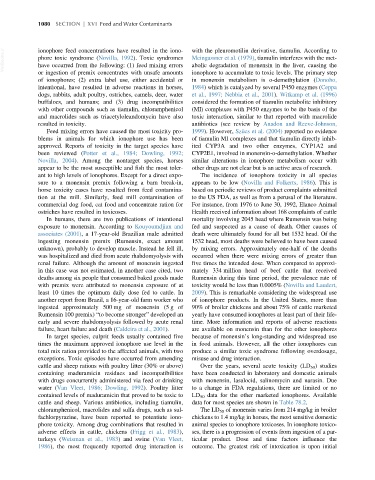Page 1148 - Veterinary Toxicology, Basic and Clinical Principles, 3rd Edition
P. 1148
1080 SECTION | XVI Feed and Water Contaminants
VetBooks.ir ionophore feed concentrations have resulted in the iono- with the pleuromotilin derivative, tiamulin. According to
Meingassner et al. (1979), tiamulin interferes with the met-
phore toxic syndrome (Novilla, 1992). Toxic syndromes
abolic degradation of monensin in the liver, causing the
have occurred from the following: (1) feed mixing errors
or ingestion of premix concentrates with unsafe amounts ionophore to accumulate to toxic levels. The primary step
of ionophores; (2) extra label use, either accidental or in monensin metabolism is o-demethylation (Donoho,
intentional, have resulted in adverse reactions in horses, 1984) which is catalyzed by several P450 enzymes (Ceppa
dogs, rabbits, adult poultry, ostriches, camels, deer, water et al., 1997; Nebbia et al., 2001). Witkamp et al. (1996)
buffaloes, and humans; and (3) drug incompatibilities considered the formation of tiamulin metabolite inhibitory
with other compounds such as tiamulin, chloramphenicol (MI) complexes with P450 enzymes to be the basis of the
and macrolides such as triacetyloleandomycin have also toxic interaction, similar to that reported with macrolide
resulted in toxicity. antibiotics (see review by Anadon and Reeve-Johnson,
Feed mixing errors have caused the most toxicity pro- 1999). However, Szu ¨cs et al. (2004) reported no evidence
blems in animals for which ionophore use has been of tiamulin MI complexes and that tiamulin directly inhib-
approved. Reports of toxicity in the target species have ited CYP3A and two other enzymes, CYP1A2 and
been reviewed (Potter et al., 1984; Dowling, 1992; CYP2E1, involved in monensin-o-demethylation. Whether
Novilla, 2004). Among the nontarget species, horses similar alterations in ionophore metabolism occur with
appear to be the most susceptible and fish the most toler- other drugs are not clear but is an active area of research.
ant to high levels of ionophores. Except for a direct expo- The incidence of ionophore toxicity in all species
sure to a monensin premix following a barn break-in, appears to be low (Novilla and Folkerts, 1986). This is
horse toxicity cases have resulted from feed contamina- based on periodic reviews of product complaints submitted
tion at the mill. Similarly, feed mill contamination of to the US FDA, as well as from a perusal of the literature.
commercial dog food, cat food and concentrate ration for For instance, from 1976 to June 30, 1992, Elanco Animal
ostriches have resulted in toxicoses. Health received information about 168 complaints of cattle
In humans, there are two publications of intentional mortality involving 2045 head where Rumensin was being
exposure to monensin. According to Kouyoumdjian and fed and suspected as a cause of death. Other causes of
associates (2001), a 17-year-old Brazilian male admitted death were ultimately found for all but 1532 head. Of the
ingesting monensin premix (Rumensin, exact amount 1532 head, most deaths were believed to have been caused
unknown), probably to develop muscle. Instead he fell ill, by mixing errors. Approximately one-half of the deaths
was hospitalized and died from acute rhabdomyolysis with occurred when there were mixing errors of greater than
renal failure. Although the amount of monensin ingested five times the intended dose. When compared to approxi-
in this case was not estimated, in another case cited, two mately 334 million head of beef cattle that received
deaths among six people that consumed baked goods made Rumensin during this time period, the prevalence rate of
with premix were attributed to monensin exposure of at toxicity would be less than 0.0005% (Novilla and Laudert,
least 10 times the optimum daily dose fed to cattle. In 2009). This is remarkable considering the widespread use
another report from Brazil, a 16-year-old farm worker who of ionophore products. In the United States, more than
ingested approximately 500 mg of monensin (5 g of 90% of broiler chickens and about 75% of cattle marketed
Rumensin 100 premix) “to become stronger” developed an yearly have consumed ionophores at least part of their life-
early and severe rhabdomyolysis followed by acute renal time. More information and reports of adverse reactions
failure, heart failure and death (Caldeira et al., 2001). are available on monensin than for the other ionophores
In target species, culprit feeds usually contained five because of monensin’s long-standing and widespread use
times the maximum approved ionophore use level in the in food animals. However, all the other ionophores can
total mix ration provided to the affected animals, with two produce a similar toxic syndrome following overdosage,
exceptions. Toxic episodes have occurred from amending misuse and drug interaction.
cattle and sheep rations with poultry litter (30% or above) Over the years, several acute toxicity (LD 50 ) studies
containing maduramicin residues and incompatibilities have been conducted in laboratory and domestic animals
with drugs concurrently administered via feed or drinking with monensin, lasalocid, salinomycin and narasin. Due
water (Van Vleet, 1986; Dowling, 1992). Poultry litter to a change in FDA regulations, there are limited or no
contained levels of maduramicin that proved to be toxic to LD 50 data for the other marketed ionophores. Available
cattle and sheep. Various antibiotics, including tiamulin, data for most species are shown in Table 78.2.
chloramphenicol, macrolides and sulfa drugs, such as sul- The LD 50 of monensin varies from 214 mg/kg in broiler
fachlorpyrazine, have been reported to potentiate iono- chickens to 1.4 mg/kg in horses, the most sensitive domestic
phore toxicity. Among drug combinations that resulted in animal species to ionophore toxicoses. In ionophore toxico-
adverse effects in cattle, chickens (Frigg et al., 1983), ses, there is a progression of events from ingestion of a par-
turkeys (Weisman et al., 1983) and swine (Van Vleet, ticular product. Dose and time factors influence the
1986), the most frequently reported drug interaction is outcome. The greatest risk of intoxication is upon initial

